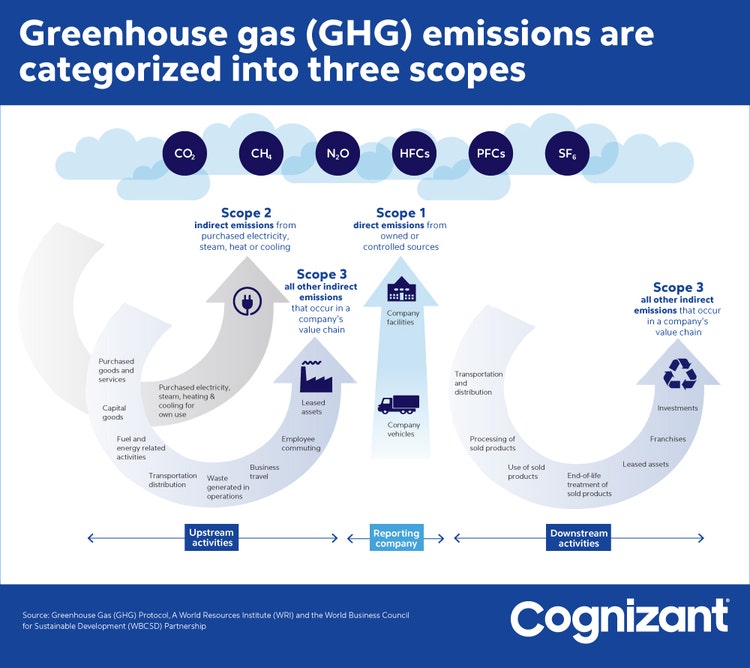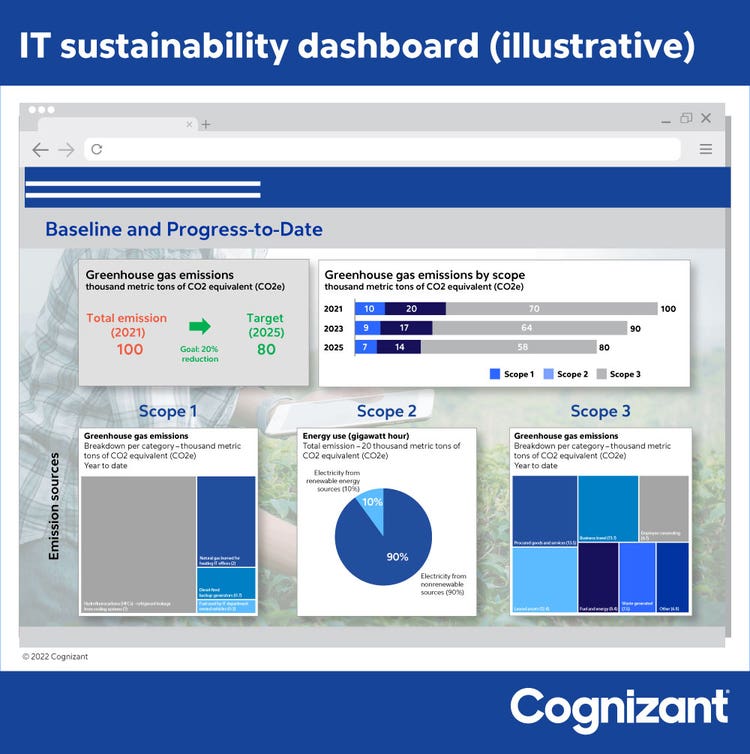
Sustainability: Leveraging green IT to get to net zero styles-h2 text-white
data-xy-axis-lg:null; data-xy-axis-md:null; data-xy-axis-sm:80% 40%
<p><span class="medium"><br>February 16, 2022</span></p>
Sustainability: Leveraging green IT to get to net zero
<p><b>IT organizations should lead by example, proving to the broader business that its carbon footprint can be dramatically reduced. We’re helping global companies do just that.</b></p>
<p>After COP26, the climate-change conference held late last year, there is hope that climate commitments launched in Glasgow will turn into action on reducing carbon emissions. In addition to fending off climate disasters and garnering glowing public relations, businesses have many good reasons to act. Yet <a href="https://zerotracker.net/analysis/post-cop26-snapshot/" target="_blank">while 43% of the world’s 632 largest public companies have net-zero commitments</a>, two-thirds of them fail to identify specific, clear conditions to get there. Meanwhile, more than <a href="/content/dam/connectedassets/cognizant-global-marketing/marketing-channels/cognizant-dotcom/en_us/insights/documents/green-rush-the-economic-imperative-for-sustainability-codex6516.pdf" target="_blank">three-quarters of business leaders</a> cite ROI uncertainty as an obstacle to achieving net zero.</p> <p>There is, in fact, a strong business case for net zero. Research shows that companies with high environmental, social and governance (ESG) ratings have a lower cost of debt and equity. And a Cognizant <a href="/content/dam/connectedassets/cognizant-global-marketing/marketing-channels/cognizant-dotcom/en_us/insights/documents/green-rush-the-economic-imperative-for-sustainability-codex6516.pdf" target="_blank">study</a> points to companies improving sales by virtue of ESG compliance. Yet it remains unclear whether this is a credible movement or whether many of these companies are just “<a href="https://www.forbes.com/sites/beauriver/2021/04/29/the-increasing-dangers-of-corporate-greenwashing-in-the-era-of-sustainability/?sh=b68e1544a325" target="_blank">greenwashing</a>.”</p> <p>At the same time, businesses are looking to digital technology and innovation to help them meet emission reduction goals. For example, in the Cognizant study, 77% of respondents said environmental sensors and the internet of things (IoT) are critical to sustainability.</p> <p>Opportunities abound. Simply shifting from desktop computers and televisions to smartphones requires fewer materials, energy, and network bandwidth. <a href="https://www.ericsson.com/en/reports-and-papers/research-papers/exploring-the-effects-of-ict-solutions-on-ghg-emissions-in-2030" target="_blank">Another study predicts</a> that a reduction of global CO2e emissions can be achieved through smart use of information and communications technology (ICT). The holy grail for companies is to reduce supply chain-related emissions, referred to in Scope 3 in the following figure, which accounts for 65% to 95% of <a href="https://www.carbontrust.com/news-and-events/events/2021/11/scope-3-emissions-carlsberg-carbon-trust" target="_blank">total emissions</a> in some industries.</p>

#
<p><br> </p>
Quick take
Greenhouse gas (GHG) emissions are categorized into three scopes:
- Scope 1 covers direct emissions from owned or controlled sources
- Scope 2 covers indirect emissions from purchased electricity, steam, heat or cooling
- Scope 3 includes all other indirect emissions that occur in a company's value chain
While Scope 3 includes 65 to 95% of total emissions depending on industry, it represents less than a third (32%) of all corporate net-zero targets.
<h4><br> Green IT: From myth to promise</h4> <p>This is all very promising, but for now, the ICT sector is struggling to control its own emissions. Socially distant interaction throughout the pandemic boosted internet traffic by <a href="https://www.iea.org/reports/data-centres-and-data-transmission-networks" target="_blank">40% in 2020</a>. A <a href="https://www.sciencedirect.com/science/article/pii/S2666389921001884" target="_blank">recent study</a> estimates that ICT is responsible for as much as 3.9% of the total carbon footprint. </p> <p>This status quo provides a significant opportunity for IT leaders to put the “green” into Green IT. C-suite executives who are serious about net zero are using multi-pronged plans to launch corporate initiatives.</p> <p>For example, we recently worked with a global food and beverage company to launch its journey to reduce carbon emissions. The CIO wanted to understand and identify the strongest opportunities and cases for IT sustainability. This effort did not simply snap into place using existing company processes and practices; it called for leaders to get out of their comfort zone. Like many companies, this client struggled to collect, measure and analyze data unique to sustainability, and to dynamically optimize IT and business processes to meet emission reduction goals.</p> <p>What follows is a five-step approach we used to help this company (and others) move into launch mode and embark on a net-zero journey.</p> <h4>Step 1: Assess existing IT processes and data to shape a green-IT vision</h4> <p>The most critical step is measuring to take action. Conduct a baseline assessment of all emissions for the most recent full calendar year. Use globally accepted <a href="https://www.wbcsd.org/Programs/Climate-and-Energy/Climate/Resources/A-corporate-reporting-and-accounting-standard-revised-edition" target="_blank">GHG accounting and reporting standards</a> to develop your emissions baseline and set a net-zero goal. The key is to get started.</p> <h4>Step 2: Prioritize critical emission/projects and build a roadmap</h4> <p>Use relative quantitative ranking to identify critical emission/projects in the three scope areas (see Quick Take). Conduct a materiality assessment, quantify the baseline, and prioritize key performance indicators (KPIs). KPIs must be aligned with the relevant stakeholders who are responsible for driving execution. Develop a three-year roadmap to build capabilities in terms of resources, best practices, and budget requirements to meet the organization’s emission goals. It is also essential to build SMART goals (for example, measure emission benefits from moving an application to the cloud by releasing servers from your company’s data centers) to measure progress and keep stakeholders accountable for overall emission reduction goals.</p> <h4>Step 3: Build a business intelligence reporting infrastructure</h4> <p>Building a business intelligence infrastructure requires identifying the relevant data sources from disparate systems. Because sustainability is an afterthought at most companies, the effort involved in locating this critical data cannot be understated. With data in place, a calculation methodology can be applied; dashboards can then be used to track progress. From there, construct the right foundation built on a data lake to support sustainability key metrics and automatically feed the dashboard.<br> </p>

#
<h4><br> Step 4: Develop governance and competence structures to drive cross-organization buy-in</h4> <p>The success of green IT programs depends on building the right organization to create sustainability-related capabilities. An IT sustainability center of excellence (COE) model helps coordinate this effort with various departments under the IT umbrella. This includes IT-specific procurement and supplier management, infrastructure and operations, and corporate functions such as finance and HR (for example, providing employee commute data).</p> <p>Ideally sponsored by the CIO or CTO, the COE helps establish goals and objectives by driving ownership for emission goals and the associated interdependencies and trade-offs into these departments. For example, using blockchain in the supply chain for product and supplier provenance is generally expected to increase emissions but will provide business benefits by driving responsible sourcing and better visibility.</p> <h4>Step 5: Communicate progress to stakeholders</h4> <p>As in any critical IT project, change management and communication are essential for creating general awareness of sustainability initiatives. Stakeholders must be shown that they can generate results that will support their key responsibility areas by thinking outside the box. For example, when powering your company’s data center, do not reflexively turn to non-renewable energy sources. Instead, seek out and evaluate a renewable source like solar energy, which may be <a href="https://www.weforum.org/agenda/2021/07/renewables-cheapest-energy-source" target="_blank" rel="noopener noreferrer">more cost-effective</a> in the long run. Another example: Extending the end of life for devices where possible can defer additional spending, which generates savings and frees up funds for new initiatives, such as sustainability.</p> <p>Our work for the previously mentioned global food and beverage company delivered the following results:</p> <ul> <li><b>A scientific calculation of its emission baseline. </b>We helped the company move from a simple but less accurate emission calculation method based on IT spend (average emission per dollar of IT spend) to a more scientific approach defined by <a href="https://ghgprotocol.org/scope-3-technical-calculation-guidance" target="_blank" rel="noopener noreferrer">GHG Protocol</a>, in line with climate science standards generated from the <a href="https://unfccc.int/process-and-meetings/the-paris-agreement/the-paris-agreement" target="_blank" rel="noopener noreferrer">Paris Agreement</a>.<br> <br> </li> <li><b>An actionable plan to accelerate IT emission reduction.</b> We created a database to support the client’s first IT sustainability dashboard. Its IT function now monitors emission sources like the data center, technology assets, cloud activities, energy usage, and business travel to calculate emission reduction opportunities. We identified metrics that include natural gas burned for heating, refrigerant leakage, procured electricity, and share of renewables. Business travel (total miles and emissions) and the number of decommissioned, re-used, or recycled devices are all now measured.<br> <br> </li> <li><b>Progress toward achieving net-zero emissions five years before corporate goals.</b> Our suggested initiatives and roadmap called for moving from fossil-fuel-powered generators to a backup battery, migrating the data center to an efficient cloud platform, and sourcing from suppliers that already meet sustainability criteria. All told, this effort helped IT meet its net-zero emission goal by 2025 — five years ahead of the organization as a whole. We advised the company to phase out renewable energy credits to procure wind-based and solar-based energy from suppliers, directly leading to savings and positive change on sustainability.</li> </ul> <p>Companies have a choice: They can utilize IT in the old way, expanding the carbon footprint, or IT can be positioned to lead the effort to meet sustainability goals. Indeed, technology will be critical to help transform processes, build new products and services, and provide IoT-enabled real-time monitoring of environmental conditions.</p> <p>But to be credible, IT needs to show the path of emission reduction from its own footprint, which, as demonstrated, can be achieved sooner rather than later. These efforts will elevate IT leaders as they help other departments pursue net-zero emissions.</p> <p><i>This article was written by Durgesh Narayan Patel, a director within Cognizant’s IoT, Engineering and Sustainability Practice.</i></p> <p><i>For more insight, visit the <a href="https://www.cognizant.com/us/en/services/sustainability-services" target="_blank" rel="noopener noreferrer">Cognizant Sustainability Services</a> section of our website, or <a href="/content/cognizant-dot-com/us/en/about-cognizant/contact-us.html" target="_blank" rel="noopener noreferrer">contact us</a>.</i></p>
<p>We’re here to offer you practical and unique solutions to today’s most pressing technology challenges. Across industries and markets, get inspired today for success tomorrow.</p>
